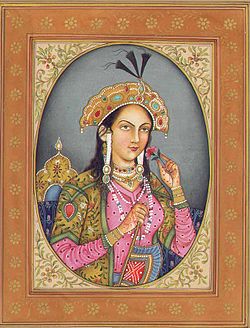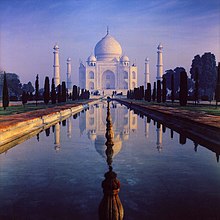Mumtaz Mahal
From Wikipedia, the free encyclopedia
For other uses, see Mumtaz Mahal (disambiguation).
| Mumtaz Mahal | |||||
|---|---|---|---|---|---|
| Empress consort of the Mughal Empire | |||||

An artistic depiction of Mumtaz Mahal
| |||||
| Tenure | 8 November 1627 – 17 June 1631 | ||||
| Spouse | Shah Jahan | ||||
| Issue | Hur un-nisa Begum (1613–1619) Jahanara Begum (1614–1681) Dara Shikoh (1615–1659) Shah Shuja (1616–1661) Roshanara Begum (1617–1661) Aurangzeb (1618–1707) Sultan Ahmad Bakhsh (1619–1622) Soraya Banu Begum (1621–1628) Murad Baksh (1624–1661) Roshan Rai Begum (1625) Lutfullah Mirza (1626–1628) Daulat Afzal Mirza (1628–1629) Husn Ara Begum (1630) Gauharara Begum (1631–1707) | ||||
| |||||
| House | Timurid (by marriage) | ||||
| Father | Abdul Hasan Asaf Khan | ||||
| Mother | Plondregi Begum | ||||
| Born | 1 September 1593 Agra, Mughal Empire | ||||
| Died | 17 June 1631 Burhanpur, Mughal Empire | ||||
| Burial | Taj Mahal | ||||
| Religion | Shia Islam | ||||
Mumtaz Mahal (1 September 1593 – 17 June 1631) [mumˈt̪aːz mɛˈɦɛl]; meaning "the chosen one of the palace") was a Mughal Empress and chief consort of emperorShah Jahan. The Taj Mahal in Agra was constructed by her husband as her final resting place.
Born as Arjumand Banu Begum in Agra in a family of Persian nobility as a daughter of Abdul Hasan Asaf Khan, making her a niece and later daughter-in-law of EmpressNur Jehan, the wife of the emperor Jahangir.[1] Arjumand Banu Begum was married at the age of 19, on 10 May 1612, to Prince Khurram, later known as Emperor Shah Jahan, who conferred upon her the title "Mumtaz Mahal". Though betrothed to Shah Jahan in 1607, she ultimately became his second wife in 1612 and was his favorite. She died in Burhanpur in the Deccan (now in Madhya Pradesh) during the birth of their fourteenth child, a daughter named Gauhara Begum.[2]
Mumtaz Mahal mothered fourteen children by Shah Jahan, including Aurangzeb, the Imperial Prince Dara Shikoh, the heir apparent anointed by Shah Jahan, who temporarily succeeded Shah Jahan until deposed by his brother Aurangzeb, and Jahanara Begum, the Imperial Princess.
Family[edit]
Arjumand Banu Begum was born in Agra in a family of Mughal nobility as a daughter of Abdul Hasan Asaf Khan, making her a niece (and later daughter-in-law) of Empress Nur Jehan, the wife of the emperor Jahangir.[1] Her older sister, Parwar Khanum, married Sheikh Farid, the son of Nawab Qutubuddin Koka, the governor ofBadaun who was also the emperor Jahangir's foster brother. Empress Mumtaz was religiously a Shia Muslim.[3]
Marriage[edit]
In 1607 AD (1016 AH), Prince Khurram, also known as Shah Jahan, was betrothed to Arjumand Banu Begum who was just 14 years old at the time, but would nonetheless become the unquestioned love of his life. They would, however, have to wait five years before they were married in 1612 AD (1021 AH), on a date selected by the court astrologers as most conducive to ensuring a happy marriage. After their wedding celebrations, Khurram "finding her in appearance and character elect among all the women of the time", gave her the title 'Mumtaz Mahal' Begum (Chosen One of the Palace).[4] 18 AH). The intervening years had seen Khurram take two other wives. But by all accounts however, Khurram was so taken with Mumtaz that he showed little interest in exercising his polygamous rights with the two earlier wives, other than dutifully siring a child with each. According to the official court chronicler, Motamid Khan (as recorded in his Iqbal Namah-e-Jahangiri), the relationship with his other wives "had nothing more than the status of marriage. The intimacy, deep affection, attention and favour which His Majesty had for the Cradle of Excellence (Mumtaz) exceeded by a thousand times what he felt for any other."[4][5][6]
Mumtaz Mahal had a deep and loving marriage with Shah Jahan. Even during her lifetime, poets would extol her beauty, grace, and compassion. She was Shah Jahan's trusted companion, travelling with him all over the Mughal Empire. His trust in her was so great that he even gave her his imperial seal, the Muhr Uzah. Mumtaz was portrayed as having no aspirations to political power in contrast to her aunt, Empress Nur Jehan, the chief consort of Emperor Jahangir, who had wielded considerable influence in the previous reign.[7] A great influence on him, apparently often intervening on behalf of the poor and destitute, she also enjoyed watching elephant and combat fights performed for the court. It was quite common for women of noble birth to commission architecture in the Mughal Empire, so Mumtaz devoted some time to a riverside garden in Agra.
Despite her frequent pregnancies, Mumtaz travelled with Shah Jahan's entourage throughout his earlier military campaigns and the subsequent rebellion against his father. She was his constant companion and trusted confidant, leading court historians to go to unheard lengths to document the intimate and erotic relationship the couple enjoyed. In their nineteen years of marriage, they had fourteen children together, seven of whom died at birth or at a very young age.[2][citation needed]
When Shah Jahan travelled from Balapur Fort to Burhanpur, mother of Mirza Azam and elder daughter of Shahzada Mirza Badi-uz-Zaman Safavi, alias Shah Nawaz Khan of the Safavid dynasty, the princess Dilras Banu Begum, wife of Aurangzeb along with Mumtaz and cousin/brother Shah Beg Khan, along with military personnel - stayed three nights near Argaon at Hiwarkhed, before the birth of their fourteenth child.[citation needed]
Death and aftermath[edit]
Mumtaz Mahal died in Burhanpur in 1631 AD (1040 AH) while giving birth to her fourteenth child.[2] She had been accompanying her husband while he was fighting a campaign in the Deccan Plateau. Her body was temporarily buried at Burhanpur in a walled pleasure garden known as Zainabad originally constructed by Shah Jahan's uncle Daniyal on the bank of the Tapti River.[8] The contemporary court chroniclers paid an unusual amount of attention to Mumtaz Mahal's death and Shah Jahan's grief at her demise. In the immediate aftermath of his bereavement, the emperor was reportedly inconsolable.[9] Apparently after her death, Shah Jahan went into secluded mourning for a year.[9] When he appeared again, his hair had turned white, his back was bent, and his face worn. Shah Jahan's eldest daughter, Jahanara Begum, gradually brought him out of grief and took the place of Mumtaz at court.
Her personal fortune (valued at 10,000,000 rupees) was divided by Shah Jahan between Jahanara Begum, who received half and the rest of her surviving children.[10]Burhanpur was never intended by her husband as his wife's final resting spot. As a result, her body was disinterred in December 1631 and transported in a golden casket escorted by her son Shah Shuja and the head lady in waiting of the deceased Empress back to Agra.[11] There it was interred in a small building on the banks of the Yamuna River. Shah Jahan stayed behind in Burhanpur to conclude the military campaign that had originally brought him to the region. While there, he began planning the design and construction of a suitable mausoleum and funerary garden in Agra for his wife. It was a task that would take more than 22 years to complete: the Taj Mahal.
A crater was named in her honour on asteroid 433 Eros, along with another one after her husband.
Citations[edit]
- ^ a b Abu Fazl 'Allami, Áín i Akbarí
- ^ a b c Kumar A, Monument of Love or Symbol of Maternal Death: The Story Behind the Taj Mahal, (2014), doi:10.1016/j.crwh.2014.07.001
- ^ "Waqf board handles Muslim rulers' property". The Times Of India. 2 October 2010. Retrieved 30 June 2011.
- ^ a b Koch, page 18.
- ^ Qazwini. fol. 233a translated by Begley and Desai (1984), page 14.
- ^ Bloom, J. and Blair, S. (1994). "The Art and Architecture of Islam: 1250-1800". New Haven and London: Yale University Press
- ^ Koch, page 19.
- ^ Preston, page 171.
- ^ a b Koch, page 20.
- ^ Preston, page 175.
- ^ Preston, page 176.
References[edit]
- Koch, Ebba. The Complete Taj Mahal: And the Riverfront Gardens of Agra (Hardback) (First ed.). Thames & Hudson Ltd. pp. 288 pages. ISBN 0-500-34209-1.
- Preston, Diana & Michael (2007). A Teardrop on the Cheek of Time (Hardback) (First ed.). London: Doubleday. pp. 354 pages. ISBN 978-0-385-60947-0.



No comments:
Post a Comment